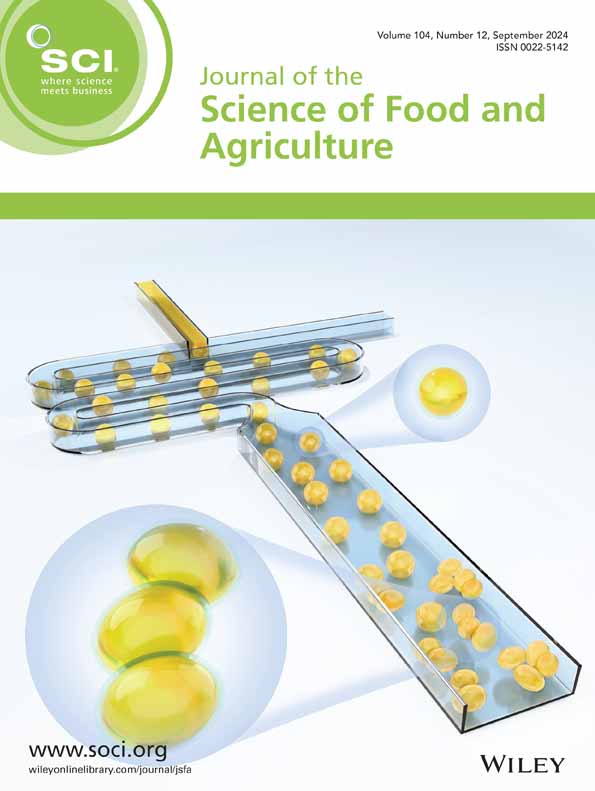求助PDF
{"title":"农业食品废弃物和发酵副产物价值的最新进展。","authors":"Fatih Tornuk, Perihan Kubra Akman","doi":"10.1002/jsfa.70160","DOIUrl":null,"url":null,"abstract":"<p><p>The agri-food industry generates huge amounts of waste and byproducts (AFWBs), which threaten the environment if not properly managed. Biological approaches such as fermentation have been proven to be versatile routes for increasing the nutritional potential of AFWBs and production of value-added bioactive compounds. The present paper reviews the results of recent studies that have been conducted on the effect of fermentation of AFWBs from different origins and fermentation techniques on generation of bioactive compounds. The study focuses specifically on studies conducted from 2020 to present. Types of microorganisms used in fermentations, fermentation routes as well as challenges towards upscaling and commercialization strategies for fermentation of AFWBs are also reviewed in this paper. Studies have indicated the production of diverse bioactive compounds including bioactive peptides, phenolics, single-cell proteins, polyunsaturated fatty acids by fermentation of AFWBs with selected bacteria, filamentous fungi and yeasts. Filamentous fungi, especially Aspergillus niger strains, have been used as starter cultures for improving the polyphenolic potential of AFWBs by fermentation, while mainly yeasts have been utilized for single-cell protein production. Peptides such as bioactive peptides and amino acids have been produced by bacterial cultures such as lactic acid bacteria and Bacillus sp. using a variety of plant- or animal-based AFWBs. Lactic acid, citric acid, essential fatty acids and flavoring compounds were also among the compounds aimed for production from AFWBs. Although the scale-up and commercialization of fermentation processes have been studied for a long time, there are still many obstacles and challenges. © 2025 Society of Chemical Industry.</p>","PeriodicalId":17725,"journal":{"name":"Journal of the Science of Food and Agriculture","volume":" ","pages":""},"PeriodicalIF":3.5000,"publicationDate":"2025-09-02","publicationTypes":"Journal Article","fieldsOfStudy":null,"isOpenAccess":false,"openAccessPdf":"","citationCount":"0","resultStr":"{\"title\":\"Recent developments in the valorization of agri-food waste and byproducts by fermentation.\",\"authors\":\"Fatih Tornuk, Perihan Kubra Akman\",\"doi\":\"10.1002/jsfa.70160\",\"DOIUrl\":null,\"url\":null,\"abstract\":\"<p><p>The agri-food industry generates huge amounts of waste and byproducts (AFWBs), which threaten the environment if not properly managed. Biological approaches such as fermentation have been proven to be versatile routes for increasing the nutritional potential of AFWBs and production of value-added bioactive compounds. The present paper reviews the results of recent studies that have been conducted on the effect of fermentation of AFWBs from different origins and fermentation techniques on generation of bioactive compounds. The study focuses specifically on studies conducted from 2020 to present. Types of microorganisms used in fermentations, fermentation routes as well as challenges towards upscaling and commercialization strategies for fermentation of AFWBs are also reviewed in this paper. Studies have indicated the production of diverse bioactive compounds including bioactive peptides, phenolics, single-cell proteins, polyunsaturated fatty acids by fermentation of AFWBs with selected bacteria, filamentous fungi and yeasts. Filamentous fungi, especially Aspergillus niger strains, have been used as starter cultures for improving the polyphenolic potential of AFWBs by fermentation, while mainly yeasts have been utilized for single-cell protein production. Peptides such as bioactive peptides and amino acids have been produced by bacterial cultures such as lactic acid bacteria and Bacillus sp. using a variety of plant- or animal-based AFWBs. Lactic acid, citric acid, essential fatty acids and flavoring compounds were also among the compounds aimed for production from AFWBs. Although the scale-up and commercialization of fermentation processes have been studied for a long time, there are still many obstacles and challenges. © 2025 Society of Chemical Industry.</p>\",\"PeriodicalId\":17725,\"journal\":{\"name\":\"Journal of the Science of Food and Agriculture\",\"volume\":\" \",\"pages\":\"\"},\"PeriodicalIF\":3.5000,\"publicationDate\":\"2025-09-02\",\"publicationTypes\":\"Journal Article\",\"fieldsOfStudy\":null,\"isOpenAccess\":false,\"openAccessPdf\":\"\",\"citationCount\":\"0\",\"resultStr\":null,\"platform\":\"Semanticscholar\",\"paperid\":null,\"PeriodicalName\":\"Journal of the Science of Food and Agriculture\",\"FirstCategoryId\":\"97\",\"ListUrlMain\":\"https://doi.org/10.1002/jsfa.70160\",\"RegionNum\":2,\"RegionCategory\":\"农林科学\",\"ArticlePicture\":[],\"TitleCN\":null,\"AbstractTextCN\":null,\"PMCID\":null,\"EPubDate\":\"\",\"PubModel\":\"\",\"JCR\":\"Q1\",\"JCRName\":\"AGRICULTURE, MULTIDISCIPLINARY\",\"Score\":null,\"Total\":0}","platform":"Semanticscholar","paperid":null,"PeriodicalName":"Journal of the Science of Food and Agriculture","FirstCategoryId":"97","ListUrlMain":"https://doi.org/10.1002/jsfa.70160","RegionNum":2,"RegionCategory":"农林科学","ArticlePicture":[],"TitleCN":null,"AbstractTextCN":null,"PMCID":null,"EPubDate":"","PubModel":"","JCR":"Q1","JCRName":"AGRICULTURE, MULTIDISCIPLINARY","Score":null,"Total":0}
引用次数: 0
引用
批量引用

 求助内容:
求助内容: 应助结果提醒方式:
应助结果提醒方式:


